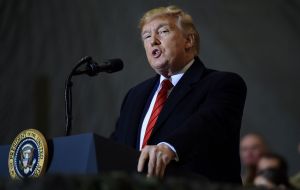MercoPress. South Atlantic News Agency
With 3.6% jobless rate, Trump plans to cut food stamp program; “we need everyone who can work, to work”
 Trump has argued that many Americans receiving food stamps through the Supplemental Nutrition Assistance Program, SNAP, do not need it
Trump has argued that many Americans receiving food stamps through the Supplemental Nutrition Assistance Program, SNAP, do not need it  ”States are seeking waivers for wide swaths of their population, and millions of people who could work are continuing to receive SNAP benefits,” he told reporters.
”States are seeking waivers for wide swaths of their population, and millions of people who could work are continuing to receive SNAP benefits,” he told reporters. The Trump administration said on Wednesday it will make it harder for states to keep residents in the U.S. food stamp program in a move that is projected to end benefits for nearly 700,000 people.
President Donald Trump has argued that many Americans receiving food stamps through the Supplemental Nutrition Assistance Program, known as SNAP, do not need it given the strong economy and low unemployment. The program provides free food to 36 million Americans.
The administration has now finalized a rule that tightens guidelines on when and where states can waive limits on how long certain residents can receive benefits. The changes will move more “able-bodied” adults into the workplace, U.S. Agriculture Secretary Sonny Perdue said.
”States are seeking waivers for wide swaths of their population, and millions of people who could work are continuing to receive SNAP benefits,” he told reporters.
The United States generally limits the amount of time that adults ages 18-49, who do not have dependents or a disability, can receive food stamps to three months in a 36-month period, unless they meet certain work requirements.
States can apply for waivers to this time limit due to tough economic conditions. However, counties with an unemployment rate as low as 2.5% have been included in waived areas, according to the U.S. Department of Agriculture, which runs SNAP.
The agency is stiffening guidelines defining where recipients can reside to be eligible for waivers and standards for demonstrating whether an area has enough jobs to justify a waiver. The U.S. unemployment rate was 3.6% in October.
“We need everyone who can work to work,” Perdue said. But critics say the moves will hurt poor Americans.
“This is an unacceptable escalation of the administration’s war on working families, and it comes during a time when too many are forced to stretch already-thin budgets to make ends meet,” said U.S. Representative Marcia Fudge, an Ohio Democrat.
The administration has sought to tighten requirements for food stamps without congressional approval after Congress blocked a Trump-backed effort to pass new restrictions through the Farm Bill last year.
The latest rule will take effect next year and save the U.S. government US$5.5 billion over five years by removing about 688,000 people from food stamps, said Brandon Lipps, a USDA deputy undersecretary.
“For those impacted it will mean less nutritious meals, or meals that are skipped altogether,” said Cassie Ramos, policy associate for the Center for Science in the Public Interest, an advocacy group.




Top Comments
Disclaimer & comment rulesCommenting for this story is now closed.
If you have a Facebook account, become a fan and comment on our Facebook Page!